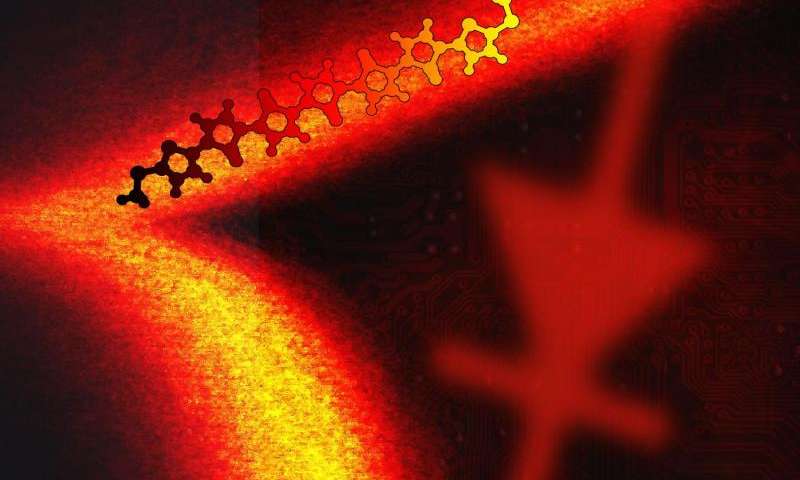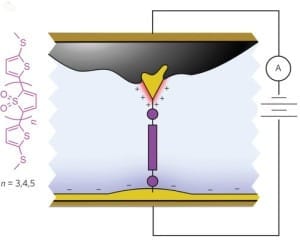
Major Milestone in Molecular Electronics Scored by Berkeley Lab and Columbia University Team
A team of researchers from Columbia University and Berkeley Lab’s Molecular Foundry has passed a major milestone in molecular electronics with the creation of a single-molecule diode that outperforms the best of its predecessors by a factor of 50.
“Using an ionic solution, two gold electrodes of dramatically different exposed surface areas, and a single symmetric molecule specially designed by the Luis Campos’ group at Columbia, we were able to create a diode that resulted in a rectification ratio, the ratio of forward to reverse current at fixed voltage, in excess of 200, a record for single-molecule devices,” says Latha Venkataraman, Associate Professor of Applied Physics at Columbia University.
“The asymmetry necessary for diode behavior originates with the different exposed electrode areas and the ionic solution,” says Jeff Neaton, Director of the Molecular Foundry, a U.S. Department of Energy (DOE) Office of Science User Facility. “This leads to different electrostatic environments surrounding the two electrodes and superlative single-molecule device behavior.”
Venkataraman, Campos and Neaton are the corresponding authors of a paper describing this research in Nature Nanotechnology. The paper is titled “Single-molecule diodes with high rectification ratios through environmental control.” The lead author is Brian Capozzi, a member of Venkataraman’s group who discovered the environmental asymmetric technique. Other co-authors are Jianlong Xia, Olgun Adak, Emma Dell, Zhen-Fei Liu and Jeffrey Taylor
With “smaller and faster” as the driving mantra of the electronics industry, single-molecule devices represent the ultimate limit in electronic miniaturization. In 1974, molecular electronics pioneers Mark Ratner and Arieh Aviram theorized that an asymmetric molecule could act as a rectifier, a one-way conductor of electric current. Since then, development of functional single-molecule electronic devices has been a major pursuit with diodes – one of the most widely used electronic components – being at the top of the list.
A typical diode consists of a silicon p-n junction between a pair of electrodes (anode and cathode) that serves as the “valve” of an electrical circuit, directing the flow of current by allowing it to pass through in only one “forward” direction. The asymmetry of a p-n junction presents the electrons with an “on/off” transport environment. Scientists have previously fashioned single-molecule diodes either through the chemical synthesis of special asymmetric molecules that are analogous to a p-n junction; or through the use of symmetric molecules with different metals as the two electrodes. However, the resulting asymmetric junctions yielded low rectification ratios, and low forward current. The Columbia University groups, working together with Neaton and his group, have discovered a way to address both deficiencies.
Read more: Meet the High-Performance Single-Molecule Diode
The Latest on: Molecular Electronics
[google_news title=”” keyword=”Molecular Electronics” num_posts=”10″ blurb_length=”0″ show_thumb=”left”]
via Google News
The Latest on: Molecular Electronics
- Pump-probe high-harmonic spectroscopy could catch geometric phase effect around conical intersection in molecule: Studyon April 29, 2024 at 1:52 pm
A collaborative research team from Nanjing University of Science and Technology (NJUST) and East China Normal University (ECNU) has theoretically proposed that a pump-probe high-harmonic spectroscopy ...
- Primary Care Shortage Reshaping How Patients Seek Careon April 29, 2024 at 5:55 am
Alternatively, the primary care shortage could be reshaping how patients seek care. A 2023 study showed the proportion of primary care preventative visits increased over 20 years. Policies under the ...
- Sustainable PCB Recycling Reducing Electronic Wasteon April 28, 2024 at 11:47 pm
Discover how this technology promises recyclability while paving the way for a more sustainable approach to electronics manufacturing.
- Clue to Aspirin, Colon Cancer Link; New Lutathera Approval; AI & Electronic Recordson April 26, 2024 at 12:51 pm
Integrating AI into electronic messaging systems may help relieve physician burden and improve patient education but still requires a "physician in the loop" as a backstop for errors in messaging. ( ...
- Molecular electronics: what will future gadgets be like?on April 26, 2024 at 6:58 am
The discovery that won the latest Nobel Prize in physics seems far away from our life, but one day everything could change with the arrival of molecular gadgets. We've tried to look into the future.
- Researcher develop high-performance amorphous p-type oxide semiconductoron April 26, 2024 at 6:56 am
Researchers have collaborated on the development of a tellurium-selenium composite oxide semiconductor material. Their efforts led to the successful creation of a high-performance and highly stable ...
- A Test Told Me I’m Basically Made of Plastic. You Probably Are Tooon April 26, 2024 at 6:13 am
“If you have a sufficiently sensitive test, you will find these chemicals in everyone,” adds Dr. Christos Symeonides, a pediatrician and the principal researcher for plastics with the Minderoo ...
- AI Can ‘Unbias’ Healthcare—But Only If We Work Together To End Data Disparityon April 26, 2024 at 5:00 am
Let us ensure that legacy approaches and biased data do not virulently infect novel and incredibly promising technological applications in healthcare.
- More efficient molecular motor widens potential applicationson April 26, 2024 at 2:00 am
Light-driven molecular motors were first developed nearly 25 years ago at the University of Groningen, the Netherlands. This resulted in a shared Nobel Prize for Chemistry for Professor Ben Feringa in ...
- Research combines DNA origami and photolithography to move one step closer to molecular computerson April 24, 2024 at 8:49 am
Molecular computer components could represent a new IT revolution and help us create cheaper, faster, smaller, and more powerful computers. Yet researchers struggle to find ways to assemble them more ...
via Bing News











